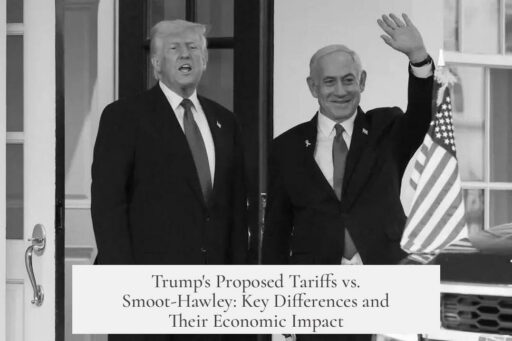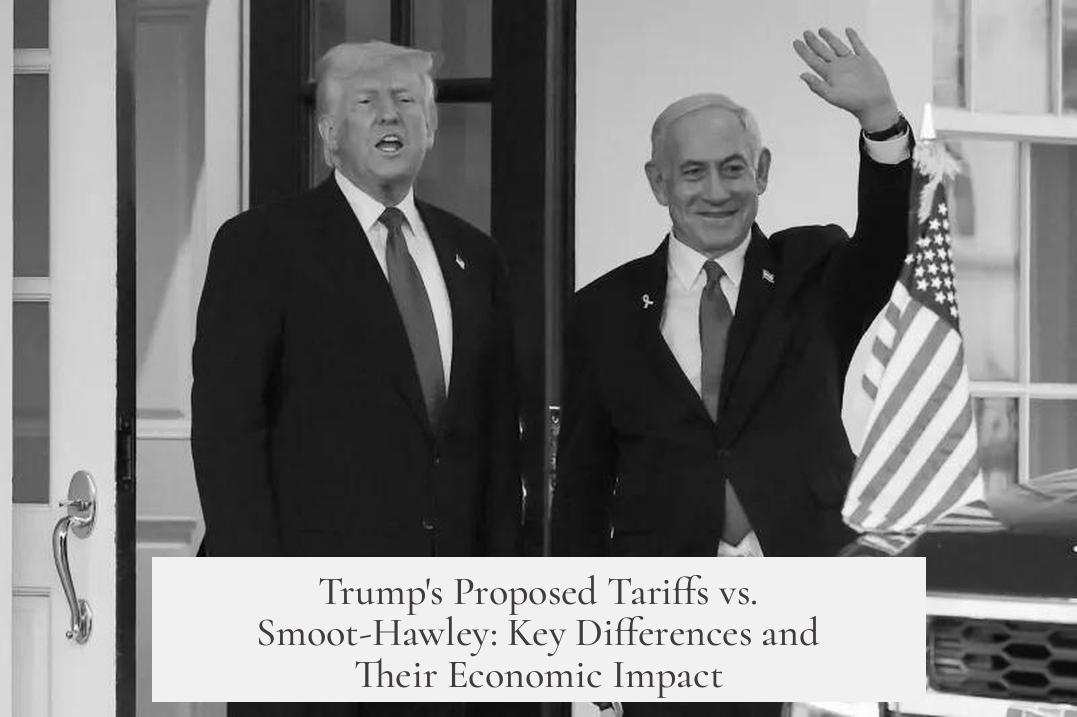The proposed Trump protective tariffs differ from the Smoot-Hawley Tariff Act of 1930 in several key aspects, including their purpose, scope, economic impact, supply chain considerations, business responses, global trade context, and political dynamics.
The Smoot-Hawley Tariff Act, enacted during the Great Depression, aimed to broadly protect U.S. industry and agriculture by raising tariffs widely across more than 20,000 imported goods to an average of 20%. Its primary reason was protectionism against global imports, targeting every trading partner rather than specific countries. In contrast, Trump’s tariffs focus specifically on China and a few other countries. These tariffs address concerns such as intellectual property theft, industrial espionage, and unfair trade practices rather than broad protectionism. The anti-China tariffs have bipartisan support aimed at addressing long-term strategic economic challenges rather than merely shielding domestic industries from all foreign competition.
Targeting differs significantly between the two policies. Smoot-Hawley applied broadly and indiscriminately to almost all foreign imports, prompting widespread retaliatory tariffs from multiple countries simultaneously. Trump’s tariffs are more selective, concentrating on China and certain other nations, with no major tariffs directed at traditional allies like Japan or Europe at this time. This approach limits the scope of retaliation and economic disruption, focusing more narrowly on bilateral disputes rather than triggering a global trade war.
Economic effects also vary. Smoot-Hawley contributed to a severe nationwide economic downturn by collapsing exports and imports broadly, worsening the Great Depression. The Trump-era trade war resulted in more localized impacts, particularly on American farmers affected by China’s retaliatory tariffs. The U.S. government responded with significant financial aid to farmers, unlike the more pervasive economic damage of the 1930s. Thus, the Trump tariffs hit specific sectors strongly but fall short of crippling the entire national economy.
Modern supply chains introduce another major difference. In 1930, manufacturing and sourcing were less complex. Companies like Ford could react to supply disruptions by establishing new factories. Today, “just in time” logistics and complex global sourcing mean tariffs quickly disrupt production through increased costs or supply shortages. Businesses struggle to find alternate suppliers, face regulatory hurdles, and must ensure compatibility of new inputs. This complexity causes tariff impacts to manifest more rapidly but in concentrated industries.
Business decision-making is more flexible yet challenging now. Instead of building new factories, modern firms seek alternative suppliers. This approach is faster but can be limited by the availability of qualified suppliers and regulatory demands. Many companies use Chinese inputs even if they benefit from tariffs on finished goods, leading to mixed industry views on the policy. In 1930, industries generally supported tariffs. Now, opinions are divided given intertwined supply chains.
The international trade environment has changed profoundly. The World Trade Organization (WTO) now exists, governing trade rules and dispute resolutions. Such frameworks did not exist during Smoot-Hawley’s era. The Trump administration has sometimes disregarded WTO rules, risking erosion of the institution’s authority. Smoot-Hawley faced no such global governance, which changes the stakes and political calculations involved.
Politically, Smoot-Hawley led to long-term consequences, including losses in Congress for decades. Trump’s tariffs reflect modern political dynamics where strategic economic competition shapes bipartisan support or opposition. Moreover, tariff levels under Trump surpass average rates from Smoot-Hawley, with some Chinese goods facing tariffs as high as 60%. However, the targeted nature and broader geopolitical rationale differentiate the overall approach.
| Aspect | Smoot-Hawley Tariff Act (1930) | Trump Protective Tariffs (2018+) |
|---|---|---|
| Reason for Tariffs | Purely broad protectionism against global imports | Targeted measures addressing IP theft, unfair practices, mainly China |
| Scope | Applied broadly to all imports | Focused on China and select countries, sparing many allies |
| Average Tariff Rate | About 20% on 20,000+ goods | Averages over 22%, with some as high as 60% |
| Economic Impact | Nationwide export collapse; worsened Great Depression | Localized industries hurt, e.g., agriculture; government bailouts implemented |
| Supply Chains | Less complex, factory-focused responses viable | Complex global supply chains, rapid impact via input disruptions |
| Business Responses | Build new factories if needed | Seek new suppliers, face regulatory challenges |
| Global Trade Framework | No WTO or similar authority | WTO exists, but US sometimes bypasses rules |
| Political Dynamics | Broad industrial support, long-term political fallout | Mixed business opinions, bipartisan strategic concerns |
- Smoot-Hawley was broad, protectionist, and global in reach; Trump tariffs are targeted and strategic.
- Trump tariffs aim at specific unfair trade practices rather than general protectionism.
- Smoot-Hawley triggered massive economic fallout; Trump tariffs caused localized damage with government aid.
- Modern complex supply chains mean quick and targeted supply disruptions under Trump policies.
- Global trade rules now govern actions; Smoot-Hawley operated without WTO constraints.
- Political and business responses are more complex and divided today.
How do the reasons behind Trump’s tariffs differ from the Smoot-Hawley Tariff Act of 1930?
Smoot-Hawley was broadly protectionist, targeting global trade to shield U.S. industries. Trump’s tariffs mainly address specific issues with China, like intellectual property theft and industrial espionage, creating bipartisan agreement on their rationale.
Why were Smoot-Hawley tariffs more damaging to the economy compared to Trump’s tariffs?
Smoot-Hawley targeted all trade partners, leading to widespread retaliatory tariffs and a hit to the entire U.S. economy. Trump’s tariffs are more focused, primarily affecting certain industries like farming, making the overall economic damage more contained.
How does the global trade environment influence the impact of these two tariff policies?
The Smoot-Hawley Act came before the WTO existed, so there were no formal trade dispute mechanisms. Trump’s tariffs occur in a world with the WTO, meaning legal and political dynamics shape responses differently than in 1930.
In what ways have modern supply chains changed the effects of Trump’s tariffs compared to Smoot-Hawley?
Modern supply chains use just-in-time inventory and rely on a few suppliers. Tariffs on Chinese goods quickly disrupt production and raise costs. Smoot-Hawley’s effects were slower since supply chains were less complex and stockpiles were larger.
How do business strategies differ between the 1930s and today regarding foreign supply disruptions?
In 1930, companies might build new factories to replace lost parts. Today, businesses seek alternative suppliers, but finding compliant, capable sources is tougher due to regulatory and quality checks, impacting production flexibility under tariffs.




